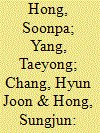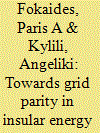|
|
|
Sort Order |
|
|
|
Items / Page
|
|
|
|
|
|
|
| Srl | Item |
| 1 |
ID:
171478


|
|
|
|
|
| Summary/Abstract |
Renewable energy electricity, such as photovoltaic (PV) power generation, has the benefits of strengthening energy security, addressing climate change, reducing air pollution, etc., but there are some impediments to deployment of renewable energy electricity: higher costs than fossil fuels, intermittent energy production, site constraints, etc. Korea changed its renewable energy electricity support systems from feed-in tariff (FIT) to a renewable portfolio standard (RPS) in 2012. This study evaluates FIT versus RPS in terms of the time to reach grid parity for PVs. Using a learning curve model, we calculate the learning rate of PV power generation during the FIT and RPS periods. We find that the PV learning rate during the RPS period was 18.44%, much higher than that during the FIT period, −0.28%, and R2 is 0.9861 and 0.7346 in the RPS and FIT periods, respectively. Using the calculated learning rate in the RPS period, we also predict that grid parity for PVs is expected in 2025 in Korea.
|
|
|
|
|
|
|
|
|
|
|
|
|
|
|
|
| 2 |
ID:
180167


|
|
|
|
|
| Summary/Abstract |
This work analyzes the grid parity of distributed photovoltaic generation (DG-PV) in the province of San Juan-Argentina, proving that currently, the levelized cost of DG-PV is on average 20% higher than the tariff price for residential customers. In order to achieve the grid parity, the provincial government should implement incentive mechanisms such as the Net Billing proposed in the National Law 27.424 (2017). The impact of the Net Billing scheme proposed in such law, from the point of view of a typical residential user, and also compared with the impact of the Net Metering and Feed-in Tariff mechanisms are presented in this work. Results show that the Net Metering scheme could be the most profitable or economically beneficial for PV-owners, but it could have some negative impact on the incomes of utilities. Besides, investment decisions in renewable distributed generation are significantly affected by technological costs, national financial conditions, and tariffs. This analysis also suggests that taxes included in the tariff structure are an important aspect to take into account for implementing incentive mechanisms. Finally, some energy policies are recommended to guarantee the profitability of DG-PV systems and to assist the government in making decisions to promote these systems.
|
|
|
|
|
|
|
|
|
|
|
|
|
|
|
|
| 3 |
ID:
150773


|
|
|
|
|
| Summary/Abstract |
Installations of rooftop solar photovoltaic (PV) technology in the United States have increased dramatically in recent years, in large part because of state and federal subsidies. In the future, such subsidies may be reduced or eliminated. From the homeowner's perspective, solar PV is competitive when it can produce electricity at a cost equivalent to the retail electricity rate, a condition sometimes referred to as “socket parity”. In assessing the economic viability of residential solar PV, most existing literature considers only a few locations and fails to consider the differences in PV system cost and electricity prices that exist across the U.S. We combined insolation data from more than 1000 locations, installation costs by region, and county-level utility rates to provide a more complete economic assessment of rooftop solar PV across the U.S. We calculated the break-even electricity prices and evaluated the reductions in installed costs needed to reach socket parity. Among the scenarios considered, we estimate that only Hawaii has achieved socket parity without the use of subsidies. With subsidies, six states reach socket parity, yet widespread parity is still not achieved. We find that high installation costs and financing rates are two of the largest barriers to socket parity.
|
|
|
|
|
|
|
|
|
|
|
|
|
|
|
|
| 4 |
ID:
171485


|
|
|
|
|
| Summary/Abstract |
The “13th Five-Year Plan” for wind power has proposed that it will reach grid parity and compete with power and hydropower. Accordingly, many doubts have been raised. Is the wind power in China already equipped with conditions for grid parity? What is the impact on the development of wind power? To solve these doubts, this study employs a system dynamics model to judge whether China can achieve grid parity for wind power. First, the factor indicator system is constructed from the aspects of wind power production, consumption, and curtailment. Second, the trend of wind power curtailment, cost, revenue, and installed capacity are predicted from 2005 to 2030. Third, three scenarios are set to simulate the impact of grid parity on wind power. Empirical results show that: (1) Net revenue and installed capacity will continue to increase, while the wind power curtailment will gradually reduce. (2) When the subsidy is decreased to 0, revenue will significantly reduce, and the installed capacity will reduce by nearly 1/4. (3) The Chinese government should not abolish all subsidies for wind power to achieve grid parity in 2020. To prompt the process for the grid parity of wind power, some policy implications are proposed.
|
|
|
|
|
|
|
|
|
|
|
|
|
|
|
|
| 5 |
ID:
096739


|
|
|
|
|
| Publication |
2010.
|
| Summary/Abstract |
This paper presents results of a study of projected costs for a grid-connected PV system for domestic application in Ireland. The study is based on results from a 1.72 kWp PV system installed on a flat rooftop in Dublin, Ireland. During its first year of operation a total of 885.1 kWh/kWp of electricity was generated with a performance ratio of 81.5%. The scenarios employed in this study consider: a range of capital costs; cost dynamics based on a PV module learning rate of 20±5%; projections for global annual installed PV capacity under an advanced and moderate market growth conditions; domestic electricity cost growth of 4.5% based on historic data; and a reduction of 25% or 50% in the CO2 intensity of national electricity production by 2055. These scenarios are used to predict when system life cycle production costs fall to grid prices (grid parity).
Average NPV and electricity generation costs ranged from -€14,330 and 0.58 €/kWh and were close to zero and 0.18 €/kWh for a system installed in 2009 and 2030, respectively. However, under optimistic conditions NPVs are positive for systems installed after 2021 and grid parity occurs in 2016. Findings are compared with similar international studies.
|
|
|
|
|
|
|
|
|
|
|
|
|
|
|
|
| 6 |
ID:
097594


|
|
|
|
|
| Publication |
2010.
|
| Summary/Abstract |
This paper presents results of a study of projected costs for a grid-connected PV system for domestic application in Ireland. The study is based on results from a 1.72 kWp PV system installed on a flat rooftop in Dublin, Ireland. During its first year of operation a total of 885.1 kWh/kWp of electricity was generated with a performance ratio of 81.5%. The scenarios employed in this study consider: a range of capital costs; cost dynamics based on a PV module learning rate of 20±5%; projections for global annual installed PV capacity under an advanced and moderate market growth conditions; domestic electricity cost growth of 4.5% based on historic data; and a reduction of 25% or 50% in the CO2 intensity of national electricity production by 2055. These scenarios are used to predict when system life cycle production costs fall to grid prices (grid parity).
Average NPV and electricity generation costs ranged from -€14,330 and 0.58 €/kWh and were close to zero and 0.18 €/kWh for a system installed in 2009 and 2030, respectively. However, under optimistic conditions NPVs are positive for systems installed after 2021 and grid parity occurs in 2016. Findings are compared with similar international studies.
|
|
|
|
|
|
|
|
|
|
|
|
|
|
|
|
| 7 |
ID:
096632


|
|
|
|
|
| Publication |
2010.
|
| Summary/Abstract |
Grid parity-reducing the cost of solar energy to be competitive with conventional grid-supplied electricity-has long been hailed as the tipping point for solar dominance in the energy mix. Such expectations are likely to be overly optimistic. A realistic examination of grid parity suggests that the cost-effectiveness of distributed photovoltaic (PV) systems may be further away than many are hoping for. Furthermore, cost-effectiveness may not guarantee commercial competitiveness. Solar hot water technology is currently far more cost-effective than photovoltaic technology and has already reached grid parity in many places. Nevertheless, the market penetration of solar water heaters remains limited for reasons including unfamiliarity with the technologies and high upfront costs. These same barriers will likely hinder the adoption of distributed solar photovoltaic systems as well. The rapid growth in PV deployment in recent years is largely policy-driven and such rapid growth would not be sustainable unless governments continue to expand financial incentives and policy mandates, as well as address regulatory and market barriers.
|
|
|
|
|
|
|
|
|
|
|
|
|
|
|
|
| 8 |
ID:
127210


|
|
|
|
|
| Publication |
2014.
|
| Summary/Abstract |
Grid parity is defined as the threshold at which a grid-connected renewable energy sources (RES) system supplies electricity to the end user at the same price as grid-supplied electricity. Predictions from the 2006 time-frame expected retail grid parity for solar in the 2016 to 2020 era, but due to rapid downward pricing changes, more recent calculations have forced dramatic reductions in time scale, and the suggestion that solar has already reached grid parity in a wide variety of locations. This study presents aspects of achieving grid parity in insular energy systems, based on a case study applied in Cyprus. The analysis presents the variation of the manufacturing cost, the selling price of the produced energy, and the performance of the solar panels to examine the conditions of accomplishing grid parity event. It is also concluded that grid parity may be easier achieved in insular energy systems due to the higher cost of primary energy.
|
|
|
|
|
|
|
|
|
|
|
|
|
|
|
|
|
|
|
|
|